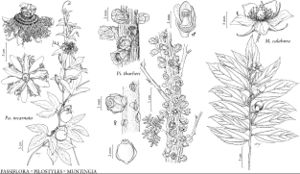Apodanthaceae
Plants apparently dioecious stem parasites, achlorophyllous; roots not produced. Stems not sessile, 1-locular anthers connate to distal portion of central column, not produced in pistillate flowers, column expanded at apex, sometimes into knob or disc; pistils in staminate flowers with only stylar column present, in pistillate flowers ovary partially inferior, indistinctly 4-carpellate or 5-carpellate, 1-locular; placentation parietal; ovules numerous. Fruits berrylike capsules, ± fleshy. Seeds numerous, minute.
Distribution
sw United States, Mexico, West Indies, Central America, South America, sw Asia, Africa, Australia, mostly in tropical areas
Discussion
Genera 2, species 10 or 11 (1 species in the flora).
The genera of Apodanthaceae as here circumscribed previously have been included in Rafflesiaceae. Molecular studies have provided evidence that the Rafflesiaceae as traditionally circumscribed (A. Cronquist 1981; W. Meijer 1993) are polyphyletic and includes three or four independent lineages (T. J. Barkman et al. 2004; D. L. Nickrent et al., www.biomedcentral.com/1471-2148-4-40; C. C. Davis et al. 2007). The Indo-Malaysian genera Rafflesia R. Brown, Rhizanthes Dumortier, and Sapria Griffith (Rafflesiaceae in the narrow sense, 20–25 species, stem and root parasites of Vitaceae), which are characterized by very large flowers, currently are thought to be related to Euphorbiaceae (Malpighiales). The two (or more) species of Mitrastemon Makino (Mitrastemonaceae, root parasites of Fagaceae), with a disjunct distribution in the Neotropics and eastern and southeastern Asia, are now placed with the Ericales. The two genera of Cytinaceae, the neotropical Bdallophytum Eichler (two species, root parasites of Burseraceae) and Cytinus Linnaeus (about eight species, root parasites on various taxa), appear to be related to the Malvales. A. Blarer et al. (2004) thought that the affinities of the Apodanthaceae were either with the Malvales or Cucurbitales; more recent molecular analyses have provided some support for the latter placement (N. Filipowicz and S. S. Renner 2010; H. Schaefer and Renner 2011b).
